Global Eye Tracking Market Forecast
- Global eye tracking market revenue to reach US$2 Bn in 2030, up from US$0.4 Bn attained in 2022
- Eye tracking market size likely to witness a CAGR of 25.2% during 2023 - 2030
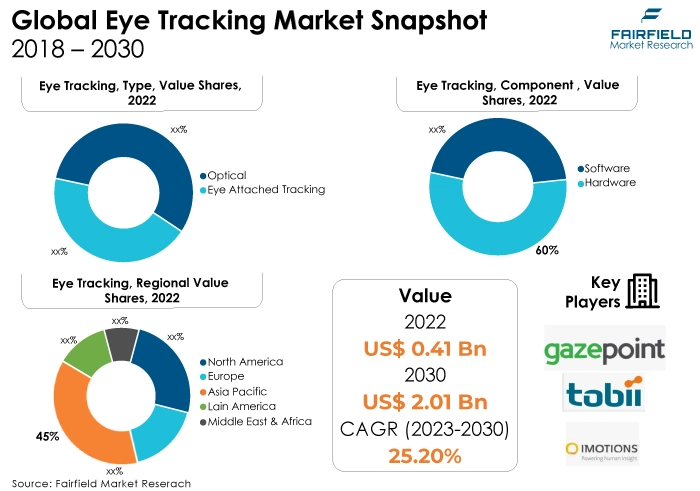
Quick Report Digest
- The key trend anticipated to fuel the eye tracking market growth is continuous advancements in eye tracking. Hardware, and software have enhanced the accuracy and reliability of eye tracking devices.
- Another major market trend expected to fuel the assistive communication industry is eye tracking technology used for diagnostics, assistive communication, and monitoring of neurological disorders.
- In 2022, eye tracking technology will be integrated into human behaviour devices such as smartphones, laptops, and gaming consoles. This integration offers users a more intuitive and interactive experience, leading to a growing demand for eye tracking features in human behaviour creating new market opportunities.
- The market can be segmented into optical eye tracking devices and eye-attached tracking devices. Optical eye tracking, based on infrared light, is widely used in human behaviour, while eye-attached tracking devices, like glasses with embedded sensors, find applications in research and assistive communication sectors.
- In 2022, eye tracking technology will find extensive applications in assistive communication, aiding in diagnosis and treatment plans. It enhances user experience in human behaviour, especially in gaming and virtual reality applications.
- The components of eye tracking systems include hardware (sensors, cameras, and processing units), and software (algorithms and analytical tools). The synergy between efficient hardware and sophisticated software is crucial for the functionality and accuracy of eye tracking devices.
- North America dominates the eye tracking market due to the high adoption of eye tracking technology in manufacturing, assistive communication, and human behaviour.
- Asia Pacific is witnessing the fastest growth in the eye tracking market. The region's strong research and development activities and significant investments in assistive communication and gaming industries are propelling market expansion.
A Look Back and a Look Forward - Comparative Analysis
The eye tracking market is experiencing robust growth driven by technological advancements and increasing applications across various industries. Eye tracking technology is widely used in assistive communication, market research, gaming, and human behaviour, fostering a surge in demand. The accuracy and efficiency of eye tracking systems have significantly improved, enhancing their adoption in medical diagnostics, assistive communication devices, and immersive gaming experiences.
The market witnessed staggered growth during the historical period 2018 – 2022. The eye tracking market witnessed substantial growth. Technological innovations led to the development of more compact and affordable eye tracking devices, expanding their reach beyond research labs. The assistive communication sector especially embraced eye tracking for diagnosing neurological disorders and enhancing patient communication.
The gaming industry also saw a surge in eye tracking integration, enhancing user experience. These trends and increased consumer awareness propelled market growth during this period.
The eye tracking market is poised for remarkable expansion. Anticipated developments include even more precise eye tracking algorithms, integration with artificial intelligence for advanced applications, and wider adoption in emerging sectors such as automotive safety systems and virtual reality interfaces. The market's future will be characterised by increasing collaborations between technology developers and industries, resulting in innovative solutions.
Moreover, the rising demand for eye tracking technology in medical research and diagnosis is expected to drive substantial market growth, making it a pivotal component of future assistive communication systems.
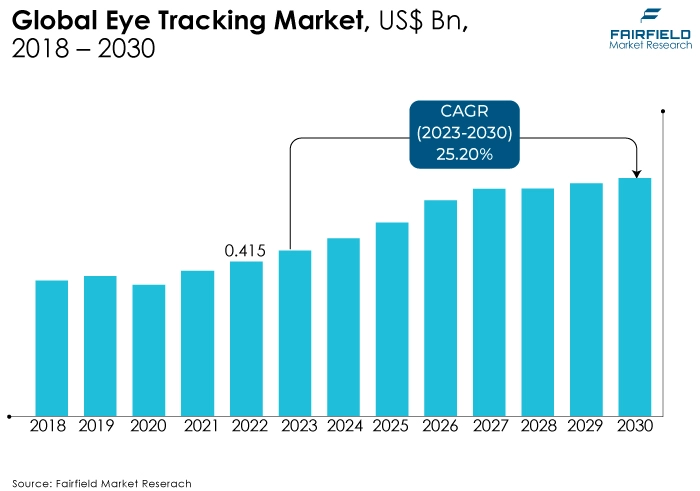
Key Growth Determinants
- Frequent Innovation, and Technological Advances
The eye tracking market is continuous technological advancements and innovation in eye tracking systems. Researchers and developers are focusing on enhancing the accuracy, speed, and reliability of eye tracking devices.
These innovations have led to more compact, portable, and affordable eye tracking solutions, making them accessible to various industries and applications.
Moreover, integration with AI, and machine learning algorithms enables real-time analysis of eye movement data, opening new avenues for research and commercial applications.
- Increasing Applications Across Diverse Industries
The widespread adoption of eye tracking technology across various industries fuels market growth. In the assistive communication sector, eye tracking is used to diagnose neurological disorders, study visual impairments, and improve assistive communication devices. In human behaviour, especially gaming, eye tracking enhances user experience by enabling more immersive and responsive gameplay.
Additionally, market research and advertising sectors utilise eye tracking data to understand consumer behaviour, leading to more effective marketing strategies. As the range of applications expands, the demand for eye tracking solutions continues to rise, driving market growth.
- Rising Demand for HCI Technologies
The increasing emphasis on improving human-computer interaction (HCI) drives the demand for eye tracking technology. Eye tracking systems play a crucial role in HCI by enabling hands-free interaction with devices, making them valuable tools for individuals with physical disabilities.
Furthermore, the integration of eye tracking in virtual reality (VR), and augmented reality (AR) environments enhances the naturalness of interactions, creating more immersive experiences for users.
As industries invest in HCI technologies to enhance user experience, the eye tracking market is witnessing a surge in demand, leading to its continuous expansion.
Major Growth Barriers
- Cost Constraints
The eye tracking market is the initial cost of eye tracking devices and systems. The advanced technology and precision engineering involved often result in expensive products, making it difficult for small businesses, researchers, or educational institutions with limited budgets to afford these solutions. The cost barrier impedes widespread adoption, particularly in emerging markets and smaller enterprises, limiting the market's growth potential.
- Data Privacy, and Ethical Concerns
Concerns of permission and privacy are brought up ethically by the gathering and use of eye movement data. The increasing integration of eye tracking technology into commonplace devices and apps has led to the demand for explicit policies and procedures pertaining to the handling and retention of private eye movement data.
For businesses, privacy violations and unauthorised access to sensitive data can have serious legal and reputational repercussions. Addressing these ethical challenges and ensuring robust data protection measures are crucial for building trust among users and overcoming barriers to market expansion.
Key Trends and Opportunities to Look at
- Integration along with VR/AR Applications
The integration of eye tracking technology with VR/AR platforms is a growing trend. It enhances user experiences by enabling more immersive interactions. Companies like Tobii, and Pupil Labs are developing eye tracking solutions for VR/AR, making these technologies more intuitive and responsive, thus gaining popularity across diverse regions.
- Rise in Assistive Communication Applications
The Assistive Communication industry is witnessing a surge in eye tracking applications for diagnosing neurological disorders, evaluating vision impairments, and enhancing rehabilitation programs. Tobii Pro, SensoMotoric Instruments, and EyeTech Digital Systems are innovating in this area. This trend is gaining traction globally, especially in North America, and Europe, thereby improving patient care and diagnostic accuracy.
- Advancements in Wearable Eye Tracking Devices
Companies like Eyegaze, and Seeing Machines are focusing on developing compact, wearable eye tracking devices. These devices find utility in various sectors, including automotive, gaming, and human behaviour. Brands are leveraging this trend by incorporating eye tracking features into products and enhancing user interfaces, and user experiences, thereby increasing market appeal globally.
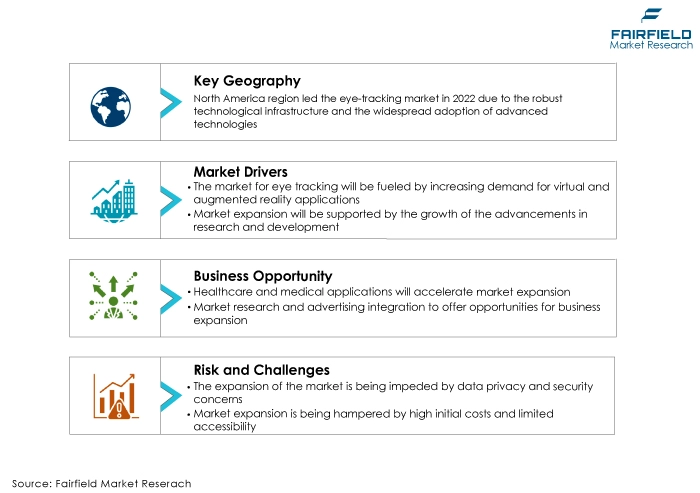
How Does the Regulatory Scenario Shape this Industry?
Various regulatory frameworks that ensure product safety, user privacy, and ethical research practices significantly influence the eye tracking market. Medical devices in the US are regulated by the FDA, which also has jurisdiction over eye tracking systems used in medical applications.
Institutional review boards, or IRBs, are responsible for monitoring adherence to ethical standards, including the Belmont Report, which direct research involving human beings. Eye tracking technology firms are impacted by the General Data Protection Regulation (GDPR), which is essential to protecting user privacy and data security in the European Union.
Moreover, organisations must adhere to the Declaration of Helsinki, a fundamental document guiding medical researchers worldwide, ensuring ethical conduct in human research. Region-specific changes also occur, with individual countries often enforcing regulations and standards. For instance, to protect patient privacy, eye tracking technologies used in Assistive Communication applications must adhere to the Health Insurance Portability and Accountability Act (HIPAA) in the US.
Additionally, industry standards like ISO 13485 for medical devices and ISO 9241 for ergonomics influence the design and manufacturing of eye tracking products, ensuring quality and safety globally.
Fairfield’s Ranking Board
Top Segments
- Optical Load Segment Leads, Eye-Attached Tracking Picks Pace
The dominant category is optical eye tracking in 2022, accounting for approximately 70% of the market share. Optical eye tracking technology uses cameras and infrared light to monitor eye movements, making it widely used in various applications such as research, assistive communication, and human behaviour.
Furthermore, eye-attached tracking has been identified as the fastest-growing category through 2030, which is experiencing a rapid surge in demand and capturing around 25% of the market share.
Eye-attached tracking devices are compact and wearable, offering mobility and convenience. They find extensive applications in AR/VR experiences, gaming, and medical diagnostics. The growing interest in immersive technologies has significantly propelled the adoption of eye-attached tracking solutions, driving their market share expansion.
- Human Behaviour Tops the Application List
In 2022, human behaviour holds a substantial market share of about 60%. For features like gaze-controlled scrolling and eye-based authentication, human behaviour applications include eye tracking in smartphones, tablets, and laptops. The widespread use of eye tracking in consumer devices has solidified its dominance in the market.
The fastest-growing category is assistive communication, which is experiencing rapid growth and capturing approximately 30% of the market share. In assistive communication, eye tracking technology is utilised for various purposes, such as diagnosing neurological disorders, studying eye movements for rehabilitation, and using assistive communication devices for people with disabilities.
The assistive communication sector's increasing adoption of eye tracking solutions for medical applications has led to its significant market share growth.
- Demand for Hardware Accounts for the Lion’s Share
The dominant category is hardware, holding a substantial market share of about 65%. Hardware components include eye tracking devices, sensors, cameras, and related equipment. The demand for high-quality and precise Hardware in eye tracking systems, especially in research and gaming applications, has contributed to the dominance of this category.
The fastest-growing category is software, which is experiencing rapid growth and capturing approximately 30% of the market share. Eye tracking software includes algorithms, analysis tools, and applications for interpreting and utilizing eye movement data.
The growth in software adoption is driven by advancements in data analysis techniques, machine learning, and AI, enhancing the capabilities of eye tracking systems. Additionally, the integration of eye tracking Software into various industries, such as marketing research and user experience testing, has further boosted the demand for software solutions in the market.
Regional Frontrunners
North America Takes the Charge
Due to several key factors, the US remains the largest revenue-contributing region in the global eye tracking market. The region's dominance can be attributed to its robust technological infrastructure, substantial investments in research and development, and the rapid adoption of eye tracking technology across various industries.
North America accounted for approximately 45% of the total revenue in the global eye tracking market. This significant market share is primarily driven by the region's strong presence in human behaviour manufacturing, including smartphones, tablets, and gaming devices, where eye tracking technology has found widespread applications.
The presence of leading tech companies and research institutions in the US, and Canada has propelled innovation in eye tracking technology. Moreover, the region has a well-established assistive communication infrastructure, where eye tracking is extensively used for diagnostics, assistive technologies, and patient monitoring, creating a substantial demand in the market.
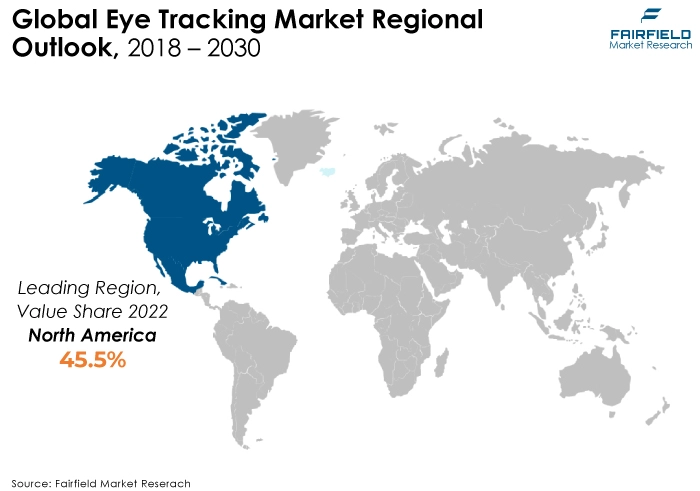
Asia Pacific likely to Witness Significant Growth in Sales During Forecast Period
Asia Pacific is expected to witness significant growth in sales in the eye tracking market during the forecast period due to various factors, driving its market share to approximately 35%. One of the primary reasons for the region’s anticipated growth is the region's advanced technological landscape and substantial investments in research and development.
Additionally, the assistive communication sector in countries like Japan, South Korea, and China has embraced eye tracking for diagnostics, assistive technologies, and research purposes, further bolstering the region’s share in the global market.
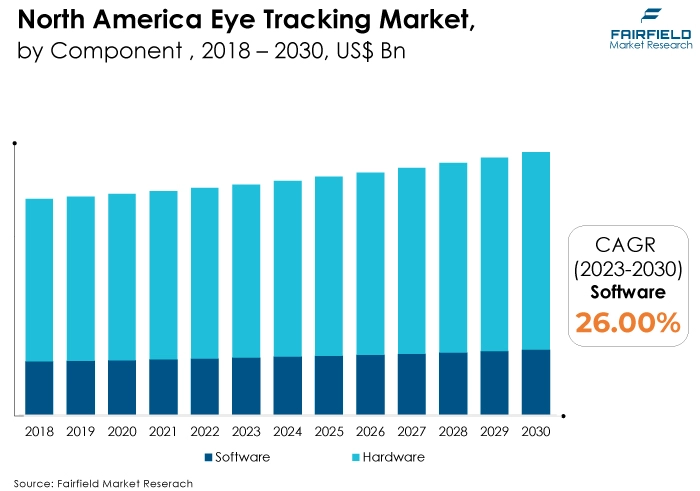
Fairfield’s Competitive Landscape Analysis
In the competitive landscape, innovation becomes the battleground. Companies investing in research and development to create more accurate, user-friendly, cost-effective eye tracking solutions will gain a competitive edge.
The market will witness intensified competition among key players, leading to continuous technological advancements and product enhancements. Strategic partnerships with software developers and integration across various platforms will further drive competition. Moreover, pricing strategies will play a pivotal role.
Who are the Leaders in Global Eye Tracking Space?
- EyeTracking Inc.
- Engineers GmbH
- Gazepoint
- LC Technologies Inc.
- Seeing Machines Ltd.
- EyeTech Digital Systems Inc.
- SensoMotoric Instruments (SMI) GmbH
- iMotions A/S
- Tobii AB
- Pupil Labs GmbH
- Smart Eye AB
- EyeLink (SR Research Ltd.)
- Polhemus
- EyeSee Research
- Skanray Technologies Pvt. Ltd.
Key Company Developments
New Product Launches
- September 2023: The Tobii Pro Fusion 4C is a new eye tracking device designed for use in research and clinical settings. It is a high-precision device that can track the gaze of multiple users at the same time.
- May 2020: The next-generation communication device with integrated eye tracking, the I-Series, has been launched by Tobii Dynavox, a commercial subsidiary of Tobii (Sweden). The new I-Series is intended for those with conditions such as amyotrophic lateral sclerosis (ALS) and cerebral palsy. It gives kids a voice so they may speak up and grow more self-reliant.
- November 2020: The upgraded CONE platform was introduced by Douglas. Case packing is quick and easy, packaging 5 to 45 cases in a minute while requiring 40% fewer components and changeover points. CpONE is easy to use and maintain because of its appealing, intelligent design.
Distribution Agreements
- June 2017: SensoMotoric Instruments, a German firm that specialised in augmented reality and eye tracking, was purchased by Apple, Inc. By making these purchases, Apple Inc. hopes to create AR and VR platforms. ARKit is one of them; it's an augmented reality framework included into iOS 11 that combines digital data and objects with the surrounding world.
- May 2017: Sticky, a cloud-based startup that provides webcam vision capturing for large-scale market research studies, was bought by Tobii Pro, the research division of Tobii AB.
An Expert’s Eye
Demand and Future Growth
The driving force behind this sustained growth is the increasing integration of eye tracking systems in various sectors. In assistive communication, it is revolutionising diagnostics and assistive technologies, improving the lives of individuals with disabilities. Gaming offers immersive experiences, changing how games are played and experienced.
Market researchers are utilizing eye tracking to gain insights into consumer behaviour, leading to more targeted marketing and enhanced user experiences. These applications, coupled with the growing demand for efficient HCI systems, are set to propel the eye tracking market into a new era.
Supply Side of the Market
According to our analysis, the complexity of the technology demands skilled professionals for the development, manufacturing, and maintenance of eye tracking devices. Additionally, the supply chain logistics, including the procurement of specialised components such as high-resolution cameras and infrared sensors, pose challenges.
Ensuring a steady supply amidst global market fluctuations and geopolitical uncertainties is critical. However, overcoming these challenges through strategic collaborations, research investments, and streamlined supply chain management can ensure a stable supply, meeting the growing demand for eye tracking solutions.
Global Eye Tracking Market is Segmented as Below:
By Type:
- Optical
- Eye Attached Tracking
By Component:
- Services
- Hardware
- Software
By Application:
- Assistive Communication
- Human Behaviour
- Other
By Geographic Coverage:
- North America
- U.S.
- Canada
- Europe
- Germany
- U.K.
- France
- Italy
- Turkey
- Russia
- Rest of Europe
- Asia Pacific
- China
- Japan
- South Korea
- India
- Southeast Asia
- Rest of Asia Pacific
- Latin America
- Brazil
- Mexico
- Argentina
- Rest of Latin America
- Middle East & Africa
- GCC
- South Africa
- Egypt
- Nigeria
- Rest of the Middle East & Africa
1. Executive Summary
1.1. Global Eye Tracking Market Snapshot
1.2. Future Projections
1.3. Key Market Trends
1.4. Regional Snapshot, by Value, 2022
1.5. Analyst Recommendations
2. Market Overview
2.1. Market Definitions and Segmentations
2.2. Market Dynamics
2.2.1. Drivers
2.2.2. Restraints
2.2.3. Market Opportunities
2.3. Value Chain Analysis
2.4. Porter’s Five Forces Analysis
2.5. COVID-19 Impact Analysis
2.5.1. Supply
2.5.2. Demand
2.6. Impact of Ukraine-Russia Conflict
2.7. Economic Overview
2.7.1. World Economic Projections
2.8. PESTLE Analysis
3. Global Eye Tracking Outlook, 2018 - 2030
3.1. Global Eye Tracking Outlook, by Type, Value (US$ Bn), 2018 - 2030
3.1.1. Key Highlights
3.1.1.1. Optical
3.1.1.2. Eye Tracking
3.2. Global Eye Tracking Outlook, by Application, Value (US$ Bn), 2018 - 2030
3.2.1. Key Highlights
3.2.1.1. Assistive Communication
3.2.1.2. Human Behaviour
3.2.1.3. Other
3.3. Global Eye Tracking Market Outlook, by Component, Value (US$ Bn), 2018 - 2030
3.3.1. Key Highlights
3.3.1.1. Hardware
3.3.1.2. Software
3.3.1.3. Services
3.4. Global Eye Tracking Outlook, by Region, Value (US$ Bn), 2018 - 2030
3.4.1. Key Highlights
3.4.1.1. North America
3.4.1.2. Europe
3.4.1.3. Asia Pacific
3.4.1.4. Latin America
3.4.1.5. Middle East & Africa
4. North America Eye Tracking Outlook, 2018 - 2030
4.1. North America Eye Tracking Outlook, by Type, Value (US$ Bn), 2018 - 2030
4.1.1. Key Highlights
4.1.1.1. Optical
4.1.1.2. Eye Tracking
4.2. North America Eye Tracking Outlook, by Application, Value (US$ Bn), 2018 - 2030
4.2.1. Key Highlights
4.2.1.1. Assistive Communication
4.2.1.2. Human Behaviour
4.2.1.3. Other
4.3. North America Eye Tracking Market Outlook, by Component, Value (US$ Bn), 2018 - 2030
4.3.1. Key Highlights
4.3.1.1. Hardware
4.3.1.2. Software
4.3.1.3. Services
4.3.2. BPS Analysis/Market Attractiveness Analysis
4.4. North America Eye Tracking Outlook, by Country, Value (US$ Bn), 2018 - 2030
4.4.1. Key Highlights
4.4.1.1. U.S. Eye Tracking by Type, Value (US$ Bn), 2018 - 2030
4.4.1.2. U.S. Eye Tracking Application, Value (US$ Bn), 2018 - 2030
4.4.1.3. U.S. Eye Tracking Market Component, Value (US$ Bn), 2018 - 2030
4.4.1.4. Canada Eye Tracking by Type, Value (US$ Bn), 2018 - 2030
4.4.1.5. Canada Eye Tracking Application, Value (US$ Bn), 2018 - 2030
4.4.1.6. Canada Eye Tracking Market Component, Value (US$ Bn), 2018 - 2030
4.4.2. BPS Analysis/Market Attractiveness Analysis
5. Europe Eye Tracking Market Outlook, 2018 - 2030
5.1. Europe Eye Tracking Outlook, by Type, Value (US$ Bn), 2018 - 2030
5.1.1. Key Highlights
5.1.1.1. Optical
5.1.1.2. Eye Tracking
5.2. Europe Eye Tracking Outlook, by Application, Value (US$ Bn), 2018 - 2030
5.2.1. Key Highlights
5.2.1.1. Assistive Communication
5.2.1.2. Human Behaviour
5.2.1.3. Other
5.3. Europe Eye Tracking Market Outlook, by Component, Value (US$ Bn), 2018 - 2030
5.3.1. Key Highlights
5.3.1.1. Hardware
5.3.1.2. Software
5.3.1.3. Services
5.3.2. BPS Analysis/Market Attractiveness Analysis
5.4. Europe Eye Tracking Outlook, by Country, Value (US$ Bn), 2018 - 2030
5.4.1. Key Highlights
5.4.1.1. Germany Eye Tracking by Type, Value (US$ Bn), 2018 - 2030
5.4.1.2. Germany Eye Tracking Application, Value (US$ Bn), 2018 - 2030
5.4.1.3. U.K. Eye Tracking by Type, Value (US$ Bn), 2018 - 2030
5.4.1.4. U.K. Eye Tracking Application, Value (US$ Bn), 2018 - 2030
5.4.1.5. U.K. Eye Tracking Market Component, Value (US$ Bn), 2018 - 2030
5.4.1.6. France Eye Tracking by Type, Value (US$ Bn), 2018 - 2030
5.4.1.7. France Eye Tracking Application, Value (US$ Bn), 2018 - 2030
5.4.1.8. France Eye Tracking Market Component, Value (US$ Bn), 2018 - 2030
5.4.1.9. Italy Eye Tracking by Type, Value (US$ Bn), 2018 - 2030
5.4.1.10. Italy Eye Tracking Application, Value (US$ Bn), 2018 - 2030
5.4.1.11. Italy Eye Tracking Market Component, Value (US$ Bn), 2018 - 2030
5.4.1.12. Turkey Eye Tracking by Type, Value (US$ Bn), 2018 - 2030
5.4.1.13. Turkey Eye Tracking Application, Value (US$ Bn), 2018 - 2030
5.4.1.14. Turkey Eye Tracking Market Component, Value (US$ Bn), 2018 - 2030
5.4.1.15. Russia Eye Tracking by Type, Value (US$ Bn), 2018 - 2030
5.4.1.16. Russia Eye Tracking Application, Value (US$ Bn), 2018 - 2030
5.4.1.17. Russia Eye Tracking Market Component, Value (US$ Bn), 2018 - 2030
5.4.1.18. Rest of Europe Eye Tracking by Type, Value (US$ Bn), 2018 - 2030
5.4.1.19. Rest of Europe Eye Tracking Application, Value (US$ Bn), 2018 - 2030
5.4.1.20. Rest of Europe Eye Tracking Market Component, Value (US$ Bn), 2018 - 2030
5.4.2. BPS Analysis/Market Attractiveness Analysis
6. Asia Pacific Eye Tracking Outlook, 2018 - 2030
6.1. Asia Pacific Eye Tracking Outlook, by Type, Value (US$ Bn), 2018 - 2030
6.1.1. Key Highlights
6.1.1.1. Optical
6.1.1.2. Eye Tracking
6.1.1.3. Other
6.2. Asia Pacific Eye Tracking Outlook, by Application, Value (US$ Bn), 2018 - 2030
6.2.1. Key Highlights
6.2.1.1. Assistive Communication
6.2.1.2. Human Behaviour
6.3. Asia Pacific Eye Tracking Market Outlook, by Component, Value (US$ Bn), 2018 - 2030
6.3.1. Key Highlights
6.3.1.1. Hardware
6.3.1.2. Software
6.3.1.3. Services
6.3.2. BPS Analysis/Market Attractiveness Analysis
6.4. Asia Pacific Eye Tracking Outlook, by Country, Value (US$ Bn), 2018 - 2030
6.4.1. Key Highlights
6.4.1.1. China Eye Tracking by Type, Value (US$ Bn), 2018 - 2030
6.4.1.2. China Eye Tracking Application, Value (US$ Bn), 2018 - 2030
6.4.1.3. China Eye Tracking Market Component, Value (US$ Bn), 2018 - 2030
6.4.1.4. Japan Eye Tracking by Type, Value (US$ Bn), 2018 - 2030
6.4.1.5. Japan Eye Tracking Application, Value (US$ Bn), 2018 - 2030
6.4.1.6. Japan Eye Tracking Market Component, Value (US$ Bn), 2018 - 2030
6.4.1.7. South Korea Eye Tracking by Type, Value (US$ Bn), 2018 - 2030
6.4.1.8. South Korea Eye Tracking Application, Value (US$ Bn), 2018 - 2030
6.4.1.9. South Korea Eye Tracking Market Component, Value (US$ Bn), 2018 - 2030
6.4.1.10. India Eye Tracking by Type, Value (US$ Bn), 2018 - 2030
6.4.1.11. India Eye Tracking Application, Value (US$ Bn), 2018 - 2030
6.4.1.12. India Eye Tracking Market Component, Value (US$ Bn), 2018 - 2030
6.4.1.13. Southeast Asia Eye Tracking by Type, Value (US$ Bn), 2018 - 2030
6.4.1.14. Southeast Asia Eye Tracking Application, Value (US$ Bn), 2018 - 2030
6.4.1.15. Southeast Asia Eye Tracking Market Component, Value (US$ Bn), 2018 - 2030
6.4.1.16. Rest of Asia Pacific Eye Tracking by Type, Value (US$ Bn), 2018 - 2030
6.4.1.17. Rest of Asia Pacific Eye Tracking Application, Value (US$ Bn), 2018 - 2030
6.4.1.18. Rest of Asia Pacific Eye Tracking Market Component, Value (US$ Bn), 2018 - 2030
6.4.2. BPS Analysis/Market Attractiveness Analysis
7. Latin America Eye Tracking Outlook, 2018 - 2030
7.1. Latin America Eye Tracking Outlook, by Type, Value (US$ Bn), 2018 - 2030
7.1.1. Key Highlights
7.1.1.1. Optical
7.1.1.2. Eye Tracking
7.2. Latin America Eye Tracking Outlook, by Application, Value (US$ Bn), 2018 - 2030
7.2.1. Key Highlights
7.2.1.1. Assistive Communication
7.2.1.2. Human Behaviour
7.2.1.3. Other
7.3. Latin America Eye Tracking Market Outlook, by Component, Value (US$ Bn), 2018 - 2030
7.3.1. Key Highlights
7.3.1.1. Hardware
7.3.1.2. Software
7.3.1.3. Services
7.3.2. BPS Analysis/Market Attractiveness Analysis
7.4. Latin America Eye Tracking Outlook, by Country, Value (US$ Bn), 2018 - 2030
7.4.1. Key Highlights
7.4.1.1. Brazil Eye Tracking by Type, Value (US$ Bn), 2018 - 2030
7.4.1.2. Brazil Eye Tracking Application, Value (US$ Bn), 2018 - 2030
7.4.1.3. Brazil Eye Tracking Market Component, Value (US$ Bn), 2018 - 2030
7.4.1.4. Mexico Eye Tracking by Type, Value (US$ Bn), 2018 - 2030
7.4.1.5. Mexico Eye Tracking Application, Value (US$ Bn), 2018 - 2030
7.4.1.6. Mexico Eye Tracking Market Component, Value (US$ Bn), 2018 - 2030
7.4.1.7. Argentina Eye Tracking by Type, Value (US$ Bn), 2018 - 2030
7.4.1.8. Argentina Eye Tracking Application, Value (US$ Bn), 2018 - 2030
7.4.1.9. Argentina Eye Tracking Market Component, Value (US$ Bn), 2018 - 2030
7.4.1.10. Rest of Latin America Eye Tracking by Type, Value (US$ Bn), 2018 - 2030
7.4.1.11. Rest of Latin America Eye Tracking Application, Value (US$ Bn), 2018 - 2030
7.4.1.12. Rest of Latin America Eye Tracking Market Component, Value (US$ Bn), 2018 - 2030
7.4.2. BPS Analysis/Market Attractiveness Analysis
8. Middle East & Africa Eye Tracking Outlook, 2018 - 2030
8.1. Middle East & Africa Eye Tracking Outlook, by Type, Value (US$ Bn), 2018 - 2030
8.1.1. Key Highlights
8.1.1.1. Optical
8.1.1.2. Eye Tracking
8.2. Middle East & Africa Eye Tracking Outlook, by Application, Value (US$ Bn), 2018 - 2030
8.2.1. Key Highlights
8.2.1.1. Assistive Communication
8.2.1.2. Human Behaviour
8.2.1.3. Other
8.3. Middle East & Africa Eye Tracking Market Outlook, by Component, Value (US$ Bn), 2018 - 2030
8.3.1. Key Highlights
8.3.1.1. Hardware
8.3.1.2. Software
8.3.1.3. Services
8.3.2. BPS Analysis/Market Attractiveness Analysis
8.4. Middle East & Africa Eye Tracking Outlook, by Country, Value (US$ Bn), 2018 - 2030
8.4.1. Key Highlights
8.4.1.1. GCC Eye Tracking by Type, Value (US$ Bn), 2018 - 2030
8.4.1.2. GCC Eye Tracking Application, Value (US$ Bn), 2018 - 2030
8.4.1.3. GCC Eye Tracking Market Component, Value (US$ Bn), 2018 - 2030
8.4.1.4. South Africa Eye Tracking by Type, Value (US$ Bn), 2018 - 2030
8.4.1.5. South Africa Eye Tracking Application, Value (US$ Bn), 2018 - 2030
8.4.1.6. South Africa Eye Tracking Market Component, Value (US$ Bn), 2018 - 2030
8.4.1.7. Egypt Eye Tracking by Type, Value (US$ Bn), 2018 - 2030
8.4.1.8. Egypt Eye Tracking Application, Value (US$ Bn), 2018 - 2030
8.4.1.9. Egypt Eye Tracking Market Component, Value (US$ Bn), 2018 - 2030
8.4.1.10. Nigeria Eye Tracking by Type, Value (US$ Bn), 2018 - 2030
8.4.1.11. Nigeria Eye Tracking Application, Value (US$ Bn), 2018 - 2030
8.4.1.12. Nigeria Eye Tracking Market Component, Value (US$ Bn), 2018 - 2030
8.4.1.13. Rest of Middle East & Africa Eye Tracking by Type, Value (US$ Bn), 2018 - 2030
8.4.1.14. Rest of Middle East & Africa Eye Tracking Application, Value (US$ Bn), 2018 - 2030
8.4.1.15. Rest of Middle East & Africa Eye Tracking Market Component, Value (US$ Bn), 2018 - 2030
8.4.2. BPS Analysis/Market Attractiveness Analysis
9. Competitive Landscape
9.1. Company Market Share Analysis, 2022
9.2. Competitive Dashboard
9.3. Company Profiles
9.3.1. Tobii AB
9.3.1.1. Company Overview
9.3.1.2. Product Portfolio
9.3.1.3. Financial Overview
9.3.1.4. Business Strategies and Development
9.3.2. iMotions A/S
9.3.2.1. Company Overview
9.3.2.2. Product Portfolio
9.3.2.3. Financial Overview
9.3.2.4. Business Strategies and Development
9.3.3. SensoMotoric Instruments (SMI) GmbH
9.3.3.1. Company Overview
9.3.3.2. Product Portfolio
9.3.3.3. Financial Overview
9.3.3.4. Business Strategies and Development
9.3.4. EyeTech Digital Systems Inc.
9.3.4.1. Company Overview
9.3.4.2. Product Portfolio
9.3.4.3. Financial Overview
9.3.4.4. Business Strategies and Development
9.3.5. Seeing Machines Ltd.
9.3.5.1. Company Overview
9.3.5.2. Product Portfolio
9.3.5.3. Financial Overview
9.3.5.4. Business Strategies and Development
9.3.6. LC Technologies Inc.
9.3.6.1. Company Overview
9.3.6.2. Product Portfolio
9.3.6.3. Financial Overview
9.3.6.4. Business Strategies and Development
9.3.7. Gazepoint
9.3.7.1. Company Overview
9.3.7.2. Product Portfolio
9.3.7.3. Financial Overview
9.3.7.4. Business Strategies and Development
9.3.8. Ergoneers GmbH
9.3.8.1. Company Overview
9.3.8.2. Product Portfolio
9.3.8.3. Financial Overview
9.3.8.4. Business Strategies and Development
9.3.9. EyeTracking Inc.
9.3.9.1. Company Overview
9.3.9.2. Product Portfolio
9.3.9.3. Business Strategies and Development
9.3.10. Pupil Labs GmbH
9.3.10.1. Company Overview
9.3.10.2. Product Portfolio
9.3.10.3. Financial Overview
9.3.10.4. Business Strategies and Development
9.3.11. Smart Eye AB
9.3.11.1. Company Overview
9.3.11.2. Product Portfolio
9.3.11.3. Financial Overview
9.3.11.4. Business Strategies and Development
9.3.12. EyeLink (SR Research Ltd.)
9.3.12.1. Company Overview
9.3.12.2. Product Portfolio
9.3.12.3. Financial Overview
9.3.12.4. Business Strategies and Development
9.3.13. Polhemus
9.3.13.1. Company Overview
9.3.13.2. Product Portfolio
9.3.13.3. Financial Overview
9.3.13.4. Business Strategies and Development
9.3.14. EyeSee Research
9.3.14.1. Company Overview
9.3.14.2. Product Portfolio
9.3.14.3. Financial Overview
9.3.14.4. Business Strategies and Development
9.3.15. Skanray Technologies Pvt. Ltd.
9.3.15.1. Company Overview
9.3.15.2. Product Portfolio
9.3.15.3. Financial Overview
9.3.15.4. Business Strategies and Development
10. Appendix
10.1. Research Methodology
10.2. Report Assumptions
10.3. Acronyms and Abbreviations
|
BASE YEAR |
HISTORICAL DATA |
FORECAST PERIOD |
UNITS |
|||
|
2022 |
|
2018 - 2022 |
2023 - 2030 |
Value: US$ Million |
||
|
REPORT FEATURES |
DETAILS |
|
Type Coverage |
|
|
Component Coverage |
|
|
Application Coverage |
|
|
Geographical Coverage |
|
|
Leading Companies |
|
|
Report Highlights |
Key Market Indicators, Macro-micro economic impact analysis, Technological Roadmap, Key Trends, Driver, Restraints, and Future Opportunities & Revenue Pockets, Porter’s 5 Forces Analysis, Historical Trend (2019-2021), Market Estimates and Forecast, Market Dynamics, Industry Trends, Competition Landscape, Category, Region, Country-wise Trends & Analysis, COVID-19 Impact Analysis (Demand and Supply Chain) |
